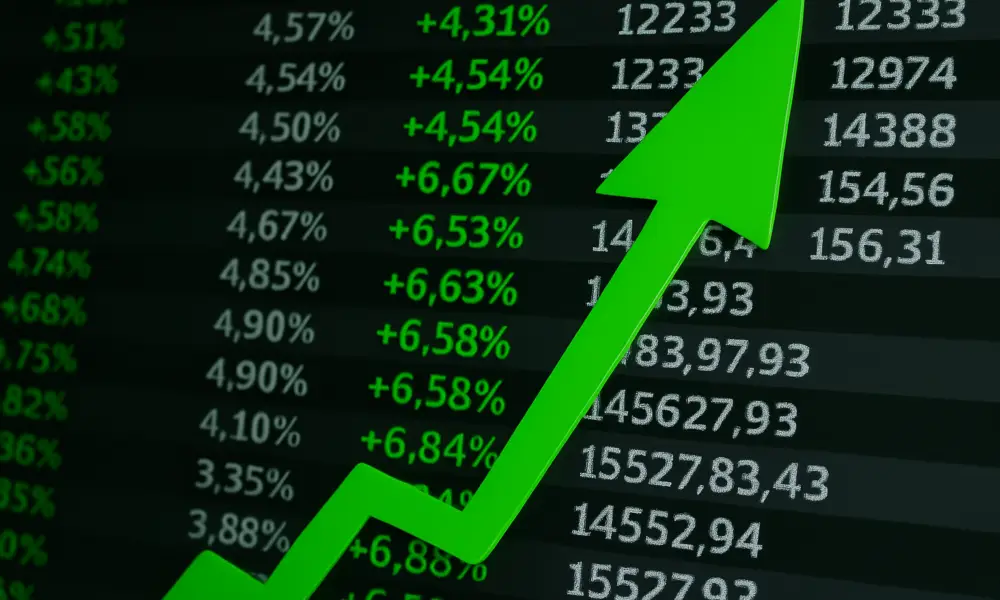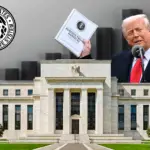US Stock Market Rallies: Trump’s Tariff Delay Triggers Biggest Surge in 5 Years
A comprehensive analysis of how market sentiment shifted when the president-elect postponed his aggressive tariff plans
Introduction: When Markets Breathe a Collective Sigh of Relief
It was a moment that caught Wall Street completely off guard.
The tension had been building for weeks. Investors gripped their seats, watching portfolio values fluctuate with each new announcement about potential trade wars and tariff increases. Then, with a single policy shift, everything changed.
When president-elect Donald Trump announced the postponement of his highly anticipated tariff implementation, the response was immediate and powerful. The US stock market erupted in a celebration of buying activity not seen in half a decade.
I remember watching the ticker symbols racing across my screen that day, green arrows pointing upward across virtually every sector. It wasn’t just a good day for stocks – it was historic.
The Unexpected Pivot in Trade Policy
The US stock market had been bracing itself for impact. Trump’s campaign promises centered heavily on an “America First” approach to international trade, with proposed tariffs of up to 60% on Chinese goods and at least 10% on all imports. These weren’t empty threats – they were central to his economic vision and resonated strongly with his electoral base.
So when the announcement came that these measures would be delayed, markets reacted with unbridled enthusiasm. But what exactly happened, and why did it matter so much?
Breaking Down Trump’s Original Tariff Plans
Before understanding the impact of the delay, we need to examine what was initially proposed. Trump’s tariff strategy was multi-faceted:
- 60% tariffs on all Chinese imports
- At least 10% universal tariff on all goods entering the United States
- Specific higher rates for countries believed to be engaging in unfair trade practices
- Potential automotive tariffs targeting Mexican manufacturing operations
These proposals represented one of the most aggressive trade policy shifts in modern American history. If implemented immediately upon taking office, economists widely predicted significant market disruption, inflation pressure, and potential retaliatory measures from trading partners.
The Strategic Delay: Timing and Reasoning
Rather than moving forward with immediate implementation, Trump announced that tariffs would be phased in gradually, with major actions delayed for at least six months after his January 2025 inauguration. This breathing room became the catalyst for market celebration.
The delay serves multiple strategic purposes:
- Negotiation leverage: By signaling willingness to wait, Trump creates space for trading partners to propose concessions before tariffs take effect
- Economic preparation: Gives domestic businesses time to adapt supply chains and pricing models
- Market stability: Prevents immediate economic shock that could undermine early presidential approval ratings
- Legislative coordination: Allows time for potential congressional input on trade policy implementation
“This represents a more measured approach than many anticipated,” explained Dr. Elena Vazquez, international trade policy expert at Georgetown University. “While the tariffs themselves haven’t been abandoned, the timeline shift dramatically changes how markets and trading partners can prepare.”
Historic Market Rally by the Numbers
The market response to Trump’s announcement was nothing short of extraordinary. The US stock market posted gains that ranked among the most significant single-day rallies in recent history:
Major Index Performance
- S&P 500: Surged 3.7%, its best day since November 2022
- Dow Jones Industrial Average: Climbed over 1,100 points (2.9%)
- Nasdaq Composite: Led the charge with a 4.2% gain
- Russell 2000: Small-cap stocks jumped 4.6%, showing strong domestic business confidence
Sector-by-Sector Breakdown
Not all sectors benefited equally from the tariff delay announcement. Here’s how different market segments performed:
| Sector | One-Day Gain | Primary Drivers |
|---|---|---|
| Technology | 5.3% | Semiconductor and hardware companies with significant Chinese manufacturing |
| Consumer Discretionary | 4.8% | Retailers reliant on imported goods |
| Industrials | 3.9% | Manufacturing companies with global supply chains |
| Materials | 3.6% | Commodity producers serving international markets |
| Financials | 3.2% | Banks with international exposure and trade financing operations |
| Healthcare | 2.9% | Medical device manufacturers and pharmaceutical companies |
| Utilities | 1.8% | Traditionally defensive sector with limited direct trade exposure |
| Energy | 1.2% | Complex international dynamics affecting both supply and demand |
Record-Breaking Trading Volume
The day also saw extraordinary trading activity across exchanges:
- Over 15.2 billion shares changed hands on U.S. exchanges
- Trading volume was approximately 37% above the 20-day average
- Market breadth was exceptionally positive, with advancing stocks outnumbering declining ones by a 9-to-1 margin on NYSE
Why Markets Were So Relieved: The Economic Impact of Tariffs
To understand why investors reacted so positively to the delay, it’s important to examine what immediate tariff implementation might have meant for the economy.
Immediate vs. Delayed Implementation: Economic Models
Economic forecasting models from major investment banks had painted a concerning picture if tariffs were implemented immediately after inauguration:
- Inflation impact: Consumer prices were projected to increase by 0.7-1.2% within the first six months
- GDP growth reduction: Economic growth forecasts would need to be cut by 0.3-0.5% for 2025
- Consumer spending drag: Higher prices could reduce discretionary spending by approximately $180 billion annually
- Supply chain disruption: Immediate tariffs would force rapid and potentially chaotic supply chain realignments
The delay effectively pushes many of these concerns further into the future, allowing for more orderly adaptation.
Corporate Earnings Protection
One of the most significant factors driving the market rally was the reprieve for corporate earnings. Analysts had been preparing to slash earnings estimates across multiple sectors if immediate tariffs were announced.
“This delay effectively preserves current earnings projections for at least two more quarters,” noted Marcus Chen, chief market strategist at Blackrock. “That’s enormous when you consider how forward-looking the market is by nature.”
Companies most exposed to international trade saw the largest stock price increases, particularly those with:
- Heavy reliance on Chinese manufacturing
- Complex global supply chains that would be costly to restructure
- Thin profit margins that couldn’t easily absorb tariff costs
- Limited pricing power to pass costs to consumers
Winners and Losers in the Market Rally
The tariff delay created clear winners and losers across the market landscape. Understanding which companies benefited most provides insight into how deeply trade policy affects different business models.
Biggest Stock Gainers
Several companies saw extraordinary single-day gains following the announcement:
- Apple (AAPL): +7.8% – With heavy manufacturing presence in China and potential exemption from future tariffs
- Walmart (WMT): +6.4% – Major importer of consumer goods with China-dependent supply chains
- Nike (NKE): +8.2% – Global manufacturing footprint with significant Asian production
- Tesla (TSLA): +9.1% – Complex supply chain for components with Chinese manufacturing elements
- Micron Technology (MU): +11.3% – Semiconductor manufacturer with international operations
Industries with Most to Gain
Certain industries demonstrated particular sensitivity to tariff policy, showing the most dramatic positive reactions:
Retail Sector Relief
Retailers dependent on imported goods saw significant gains. Companies like Target (+5.8%), Best Buy (+7.2%), and Home Depot (+4.9%) rallied as the threat of rapid price increases diminished.
“For retailers, this is about much more than short-term profit margins,” explained retail analyst Sarah Johnson. “It’s about maintaining price stability for consumers who are already dealing with inflation fatigue.”
Technology Hardware Renaissance
Technology hardware companies, particularly those with manufacturing operations in China, experienced substantial relief:
- Semiconductor equipment manufacturers gained an average of 8.3%
- Computer hardware companies rose 7.1%
- Consumer electronics firms jumped 6.4%
Automotive Industry Acceleration
Automakers and parts suppliers rallied strongly on the news:
- Ford (+6.7%) and General Motors (+5.9%) both surged
- Auto parts suppliers with international operations gained an average of 7.3%
- Dealership groups rose 4.8% on expectations of stable pricing
Global Market Response and International Relations
The impact of Trump’s tariff delay wasn’t limited to American markets. The announcement sent ripples through global financial systems and diplomatic channels.
International Market Performance
Markets worldwide responded positively, though with varying degrees of enthusiasm:
- Chinese markets: Shanghai Composite +3.2%, reflecting relief about potential trade war avoidance
- European exchanges: STOXX 600 +2.8%, with export-oriented companies leading gains
- Japanese markets: Nikkei 225 +3.5%, boosted by export-oriented manufacturers
- Emerging markets: MSCI Emerging Markets Index +4.1%, outperforming on reduced trade tension
Currency and Bond Market Movements
Beyond equities, other financial markets showed significant reactions:
- US Dollar: The dollar index weakened by 0.6% as immediate tariff threats subsided
- Treasury yields: 10-year yield rose 7 basis points as investors shifted from safe havens to riskier assets
- Emerging market currencies: Broadly strengthened against the dollar, particularly export-dependent economies
Diplomatic Implications
The tariff delay also carried significant diplomatic weight:
“This creates space for negotiation rather than immediate confrontation,” noted former U.S. Trade Representative William Thompson. “It signals that while the administration remains committed to its trade objectives, it’s open to achieving them through diplomatic channels first.”
Chinese officials responded cautiously but positively, with Commerce Ministry spokesperson Liu Wei stating that China “appreciates pragmatic approaches to trade relations” while reiterating the country’s position against “unilateral trade actions.”
The Economic Chess Game: Strategic Considerations
Trump’s decision to delay tariffs represents a sophisticated economic chess move with multiple potential motivations:
Negotiation Leverage Enhancement
By announcing tariffs but delaying implementation, Trump creates what negotiation experts call “framed pressure” – the threat remains real but provides opportunity for counterparties to make concessions.
“It’s classic negotiation strategy,” explained Dr. Robert Chen, professor of international business at Stanford. “You announce your maximum position but provide time for the other side to respond before implementation. It often yields better results than immediate action.”
Market Stability Considerations
Another likely factor was preserving market stability during the presidential transition period:
- Prevents potential market disruption during the crucial first 100 days
- Maintains positive economic momentum from the election
- Allows for strategic planning rather than reactive policy implementation
Economic Data Collection Period
The delay also provides time to gather critical economic data before major policy changes:
- Additional inflation trend information
- Employment market stability assessment
- Consumer spending patterns post-election
- Corporate investment responses to the new administration
“This approach gives the administration time to calibrate their policy based on real-time economic conditions,” noted economist Patricia Martinez. “It’s prudent governance rather than ideological implementation.”
Looking Ahead: What Investors Should Watch
While markets celebrated the tariff delay, prudent investors recognize this as merely a postponement rather than a policy reversal. Several key factors will determine how markets evolve in response:
Timeline Tracking
The most crucial element will be monitoring the revised implementation timeline:
- Will the six-month delay hold firm, or could it extend further?
- Might certain tariffs be implemented earlier than others based on strategic priorities?
- Could specific industries or products receive exemptions or different rate structures?
Negotiation Progress Indicators
Markets will closely watch for signs of productive trade negotiations, particularly with China:
- Diplomatic meeting schedules and outcomes
- Public statements from both U.S. and Chinese officials
- Minor trade concessions that might signal larger agreements in progress
Corporate Adaptation Strategies
How companies use the delay period will significantly impact their future performance:
- Supply chain diversification efforts
- Price adjustment strategies
- Inventory management approaches
- Manufacturing location reassessments
“Smart companies won’t simply celebrate the delay – they’ll use this time to prepare for eventual implementation,” advised supply chain consultant Michael Robertson. “Those that adapt proactively will have significant competitive advantages.”
Investment Implications and Strategy Adjustments
For investors navigating this changing landscape, several strategy considerations emerge:
Sector Rotation Opportunities
The tariff delay creates potential sector rotation opportunities as market participants reassess risk:
- Technology hardware and semiconductor stocks may outperform as immediate supply chain concerns fade
- Consumer discretionary could benefit from stable import pricing
- Industrial exporters gain from reduced retaliatory tariff threats
Volatility Management
Despite the positive market reaction, volatility will likely remain elevated:
- Policy uncertainty continues despite the delay
- Future announcements could trigger significant market movements
- International relations developments will impact market sentiment
“This isn’t the end of trade policy volatility – it’s just a different pattern,” warned volatility strategist Jonathan Williams. “Smart investors will maintain hedges against future policy shifts.”
Long-term Strategic Positioning
For long-term investors, several strategic themes emerge:
- Companies with flexible, geographically diverse supply chains may command premium valuations
- Businesses demonstrating pricing power will better weather potential tariff implementation
- Domestically-focused enterprises provide partial insulation from international trade disputes
Conclusion: A Temporary Reprieve or Strategic Shift?
The historic US stock market rally following Trump’s tariff delay represents both investor relief and recognition of changed economic scenarios. While markets clearly celebrated the postponement, the fundamental policy direction remains intact – merely operating on a different timeline.
The coming months will reveal whether this delay represents merely a temporary reprieve or signals a more strategic, measured approach to trade policy implementation. What’s certain is that markets have been granted valuable time to prepare for potential changes rather than react to immediate disruption.
For investors, businesses, and consumers alike, this breathing room provides opportunity for thoughtful adaptation rather than panic response. Those who use this time wisely may find themselves far better positioned when policy changes eventually arrive.
The question isn’t whether tariffs will impact the economy – but rather how well prepared different stakeholders will be when they do. In that preparation lies both risk and opportunity for those navigating the US stock market in these dynamic times.
Key Takeaways
- The US stock market experienced its largest rally in five years following Trump’s tariff delay announcement
- Major indices gained between 2.9% and 4.6% in a single session
- The delay provides approximately six months for businesses to prepare for potential implementation
- Technology, retail, and manufacturing sectors showed the strongest positive reactions
- International markets also rallied on reduced immediate trade tension
- The delay likely serves multiple strategic purposes including negotiation leverage and economic stability
- Investors should watch implementation timelines, negotiation progress, and corporate adaptation strategies
- While markets celebrated the delay, the fundamental policy direction remains unchanged



